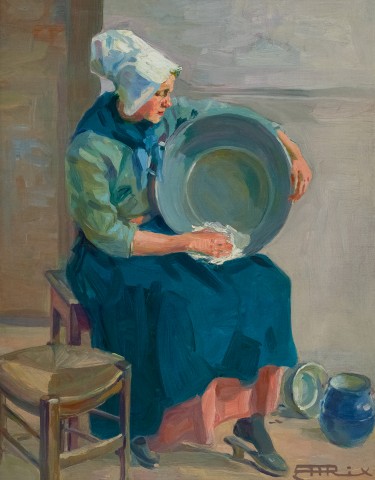LA RÉCUREUSE (THE SCULLERY MAID), c.1914
HILDA RIX NICHOLAS
oil on canvas
59.0 x 46.0 cm
signed lower right: E H Rix
Private collection, France
Sotheby’s, Melbourne, 21 December 1999, lot 122 (as ‘A Woman Cleaning’)
Private collection, Melbourne
In the years before World War One, a great number of Australian artists travelled to Europe to study, a large contingent of whom were women. All were determined to expand their creative possibilities beyond that provided by their home country; and Hilda Rix Nicholas was one of their most successful. By 1913, the local press hailed her as ‘one of the most brilliant hopes of our younger contemporary school ... (with) the right idea of movement and character.’1 Accepted into the 1911 and 1913 Paris Salon, her entries had been hung ‘on the line’, with the result that she was invited to join the membership of the Société des Peintres Orientalistes Français, also known as the Orientalists. This was an incredible achievement for a young Australian woman, as was the purchase of her work for the French Government; and La Récureuse, c.1914, dates from this remarkable phase of the artist’s early career.
Rix Nicholas was disciplined, talented and hard-working. She studied first at the National Gallery School in Melbourne between 1902 and 1905 with Frederick McCubbin as Drawing Master.2 In 1906, Hilda, her mother Elizabeth and older sister Elsie, mounted their own shared exhibition in Melbourne and the following year, all three departed for Europe with the express intention of Hilda gaining further tuition with a variety of teachers in London and Paris. Even though these were radical days for modernism’s avant-garde, Rix Nicholas aspired instead ‘to traditional values. Her dream was to be hung in the exhibitions of the conservative institutions.’3
Between 1910 and 1914, Rix Nicholas spent significant time each year in Étaples in north-west France, and La Récureuse was most likely created there using a local model. It is also likely that Iso Rae, a gallery school colleague of Elizabeth Rix, invited them to this town where she had lived for nearly twenty years (other Australian artists had also painted there previously, including Rupert Bunny and Arthur Streeton). The Rix studio was one of four built in the gardens of the Monthuys-Pannier family and Hilda was delighted to discover one of the others was occupied by the venerable and highly respected Jules Adler, an artist she considered ‘one of the greatest genre painters of France’.4 Adler was celebrated for his images which focussed on the daily lives of ordinary people, particularly workers, and Rix Nicholas benefited from his camaraderie and ‘invaluable criticisms’, as had Iso Rae before her.5 In 1912, Rix Nicholas travelled to Morocco and the local market stall-holders were impressed by the sketches she made of them, plus – importantly – by her interest in them as people, not just aesthetic tropes. This empathetic compassion extends to La Récureuse. Seated in three-quarter pose at yet another laborious chore, the young récureuse (‘she who scours’) wears a traditional starched cloth hat, work-clothes and wooden-soled slippers.6 Mostly subdued in palette, flourishes such as the violet hues in the shadows of the headwear give increased warmth to the composition. Three other paintings by Rix Nicholas of similarly dressed women can also be dated to 1914: Grandmère (Art Gallery of New South Wales); In Picardy (National Gallery of Victoria); and A mother of France Australian War Memorial). When viewed alongside, La Récureuse adds further depths of understanding to this powerful trio of women’s portraits.
1. Quote from Notre Gazette, Paris, c.1912 re-reprinted in Hilda Rix Nicholas 1884-1961: Retrospective exhibition of paintings and drawings, exhibition catalogue, Joseph Brown Gallery, Melbourne, 1971
2. Elizabeth Rix had also studied at the Gallery School between 1880 and 1883, with McCubbin as a fellow student. Other students included Arthur Streeton, Rupert Bunny and Iso Rae.
3. Travers, R., Hilda: the life of Hilda Rix Nicholas, Thames and Hudson, Melbourne, 2021, p.38
4. Ibid., p.47
5. Ibid., p.48
6. The author thanks Lucie Reeves-Smith for this translation
ANDREW GAYNOR
